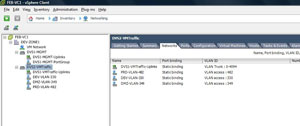Distributed Virtual Switch: Go for Two!
I've come to really like the distributed virtual switch feature of VMware's vSphere 4. The vNetwork Distributed Switch, as it is officially called, is a great way to standardize how hosts are provisioned for network configuration as well as ensure consistent monitoring of guest VMs in a distributed network.
In a previous post, I showed how you can reset a host if the distributed virtual switch configuration orphans it. Hosts can be orphaned through an incorrect VLAN assignment or the wrong network interface designation for the distributed virtual switch.
What I've come to feel the best way to provision the safest environment is to configure two or more distributed virtual switches. This creates a natural security zone separation between management and guest virtual machine networking. This separation at the distributed virtual switch level would also be a full separation by cables (as well as VLANs). The guest networking port groups would be a separate distributed virtual switch and use separate physical interfaces (see Fig. 1 for an example).
 |
| Figure 1. Two distributed virtual switches give a natural separation to follow physical media separation as well as protection against reconfiguration issues. (Click image to view larger version.) |
There are quite a few questions floating around on whether the distributed virtual switch is ready for production, Virtualization expert Mike Laverick outlines a number of them in this post. My practice going forward will be use them for all roles, including service console or ESXi's vmkernel management. The natural separation of management (including vMotion) and guest networking will make at least two distributed virtual switches in most situations. In the case of a distributed virtual switch becoming misconfigured and orphaning a host, it can be reconfigured on the fly without affecting the guest networking in the event that they are all stacked on the same virtual switch.
This really ends up matching the practice done in the standard virtual switch and port group world, making troubleshooting and logical separation intuitive.
Where are you on the distributed virtual switch? How have you separated or organized them with all of the vSphere roles? Share your comments here.
Posted by Rick Vanover on 02/04/2010 at 12:47 PM